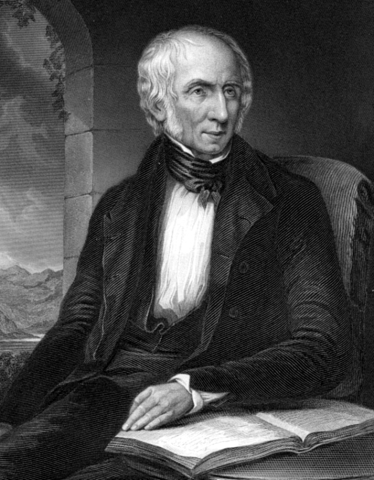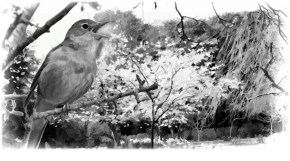
Wordsworth, William
William Wordsworth was born in 1770 in a town called Cockermouth in Cumberland. He came from a relatively well-off middle-class family, but his early years were severely disrupted by the early death of his mother when he was eight years old and the tragic death of his father when he was just 13. Until he inherited his parents’ wealth, his formative years were full of uncertainty. He was raised by members of his family, and teachers at school. His childhood was marked by a rural education in Hawkshead School in the Lake District, and his childhood differs from that of many other contemporary poets in that his childhood was exclusively rural and northern. He began writing poetry when he was a teenager, and was noted by his teachers as a promising poet, publishing his first poem when he was just 16.He went to Cambridge when he was 18 and studied Greek and Latin Literature and Mathematics, preferring the latter, and although he was a competent student he was not remarkable. In 1790 he went to France for a walking tour while France was going through the first stages of the Revolution, which would turn bloody only a few years later. In 1789 the most important prison in France, the Bastille, was sacked by Parisian workmen. This encouraged young adventurous men and women to visit France. In France Wordsworth met and became the lover of a French girl called Annette Valon, who was later to bear his child, Caroline Wordsworth. The walking tour and his experience of the Revolution in France helped him to reflect on his childhood experiences in the Lake District in England. He returned to England in 1792, around the same time that Britain declared war on France. France’s initially peaceful revolution became violent when the revolutionaries executed their king and declared France a republic. This meant that Wordsworth was unable to visit Annette and his daughter, which upset him considerably.
Back in England Wordsworth lived in London for a time and associated with what were then known as ‘radicals’. Radicals were people who called for political and social reform on a vast scale in England, and often sympathised with the French Revolution. Their primary aims were to make England more democratic, to abolish slavery and the oppression of women, and to reform corrupt financial laws. Wordsworth met the philosopher William Godwin, and although he was greatly influenced by his philosophical system, which emphasised using reason to form a rationally justified society, Wordsworth would later reject most of Godwin’s philosophy. Wordsworth had by now connected his early childhood experiences of nature, his adult reflections on nature and God, and his political philosophy, together to form a loose philosophy of life. His aim was to combine these three important experiences into poetry, which he began writing seriously in Dorset, while living with his sister Dorothy and friend Samuel Coleridge. Although Wordsworth wrote a larger volume of poetry of more consistent quality than both Dorothy and Coleridge, his two companions had a profound influence on his philosophy of nature and childhood. The result of his walking tours and discussions with philosophers such as Godwin and Coleridge was their joint venture, the collection called the Lyrical Ballads. The preface of the collection and most of the poems are written by Wordsworth. The book was published in 1798 and to mixed reviews, but in later years it was acknowledged as a revolutionary collection. It was vastly different in literary style and content from the previous 100 years of English poetry, and still has an effect on literature today. A second addition with added poems was published in 1800.
From 1800 to 1807 Wordsworth continued writing what is considered his best poetry, although he put forward a more orthodox religious system and cooled down the political content in his poems after the Lyrical Ballads. Although Wordsworth continued writing poetry after his 1807 collection, the ‘golden decade’ of 1797–1807 is considered his best work. Wordsworth also worked on an epic poem called ‘The Prelude’, which, although it was not published until after his death and exists in two editions, is arguably his greatest poetic accomplishment and one of the most influential long poems ever written. Looking back on the work of Wordsworth, Coleridge and their colleagues, we call them the Romantic Movement, but we need to keep in mind that this is a contemporary critical definition. Wordsworth would not have considered himself a ‘Romantic’, as the word meant something quite different back then.
As Wordsworth grew older he became more and more conservative socially and politically. He took up a job in the civil service in the North of England and campaigned for Tory MPs in Lancashire. Although later poets such as Keats, Shelley and Byron would later be disappointed and disillusioned by Wordsworth’s rejection of his youthful political radicalism, his philosophy of nature and childhood was absorbed and imitated by the second generation of Romantics and the Victorians. Wordsworth was appointed Poet Laureate in 1843, a final confirmation, if any were needed, that he had abandoned his radical politics and had become a solid member of the British establishment. He died in 1850.
© ZigZag Education 2025: content may be used by students for educational use if this page is referenced.
Show / hide details
| 7th April 1770 |
William Wordsworth born
|
|
| 1778 |
Wordsworth’s mother died
|
|
| 1783 |
Wordsworth’s father died
|
|
| 1787 |
First published
|
|
| 1790 |
Travelled to France
|
|
| 1792 |
Returned to England
|
|
| 1793 |
Went on a walking tour in Britain and first saw Tintern Abbey
|
|
| 1795 |
Met Samuel Coleridge
|
|
| 1798 |
Lyrical Ballads published
|
|
| 1798 |
Travelled to Germany
|
|
| 1800 |
Second edition of Lyrical Ballads published
|
|
| 1802 |
Married Mary Hutchinson
|
|
| 1807 |
Poems, in Two Volumes published
|
|
| 1810 |
Wordsworth and Coleridge were estranged
|
|
| 1843 |
Became Poet Laureate
|
|
| 1847 |
Wordsworth’s daughter Dora died
|
|
| 23rd April 1850 |
Wordsworth died
|


